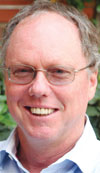
Thermal cameras are rising extensively in status and usage in the industry with the excellent detection of the presence of potential intruders, while pricing is slowly becoming more affordable. Despite being an expensive solution, the cost effectiveness of thermals for maintaining surveillance in the evening hours and dark areas is often justified. The scope of thermals in detection of the presence of suspects over significant distances also contributes to making them cost effective. The estate and mining markets in particular are areas where they are used extensively given the large perimeter areas needed to be covered, but national key points, and thermal use in protecting against cable theft is also widespread, along with a number of other industry applications.
The big advantage of thermals is the use of heat for defining the image of people and their presence in an area. Operators can usually differentiate between people and animals, even where people are crawling or in non-walking positions. False alarms may still occur though, with geographical features and other heat sources impacting on detection and false alarms. A critical part of the viewing success in using thermal cameras is not just observing what is being shown. The key factor in success in knowing the normal daytime terrain thoroughly, so the thermal camera is effectively presenting a view, almost like superimposing a heat-based filter on the operator’s existing perception of the area. Features should be recognised, especially fence lines, concealment features such as gullies, outcrops, river beds, groups of trees, and vegetation as well as components of infrastructure.
Thermals present a heat based image of a person with no chance for identification of any facial features, and limited views of the body where parts overlap or certain postures are adopted. There are, therefore, obvious limitation to the technology. However, despite not having a clear view of the person, thermals have their own body language to look for. Just the simple fact that there is a presence of the people in the area can be an issue, particularly at certain times at night when this is unexpected. Positioning at or being close to affected areas such as fence lines can raise immediate issues, and directions of movement to or away from fences or towards risk areas are critical factors to look for. Smoothness of movement, for example pausing at certain sections of the perimeter, or when a patrol moves past tells you about intentions. The volume of people can also be a critical factor in planning a response.
In additional there are particular body language activities which apply to thermals. For example, the technology is ideal for detecting behaviour such as crouching, crawling, clustering, or carrying. Movement speed including a response like scurrying away in response to threats are also distinctive. Objects being carried can sometimes be worked out by their own heat signature. In one of the mines I was training at, having infiltrated the mining area, a suspect was making off with a large section of plastic sheeting towards the fence, with the sheet heat signature trailing off behind him as he was dragging it.
There are obvious limitations to thermal cameras with any description or facial features besides build and height being impossible. However, by using natural body language and recognition of heat signatures, it is possible to use them for far more surveillance applications than may be expected. Thermals are not replacements for normal cameras, rather they have their own role in effective surveillance and are often capable to doing that exceptionally well.

Dr Craig Donald is a human factors specialist in security and CCTV. He is a director of Leaderware which provides instruments for the selection of CCTV operators, X-ray screeners and other security personnel in major operations around the world. He also runs CCTV Surveillance Skills and Body Language, and Advanced Surveillance Body Language courses for CCTV operators, supervisors and managers internationally, and consults on CCTV management. He can be contacted on +27 (0)11 787 7811 or [email protected]
| Tel: | +27 11 787 7811 |
| Email: | [email protected] |
| www: | www.leaderware.com |
| Articles: | More information and articles about Leaderware |
© Technews Publishing (Pty) Ltd. | All Rights Reserved.